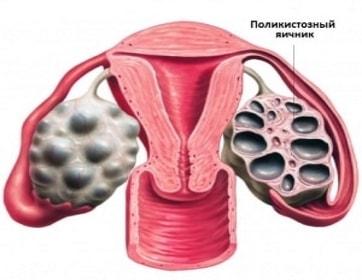- What principles is the diet for polycystic ovary syndrome based on?
- Acceptable and prohibited foods for polycystic ovary syndrome
- Folk remedies for polycystic ovary syndrome
| Polycystic ovary syndrome is a genital disease that is associated with hormonal imbalance and the development of obesity, and sometimes diabetes mellitus. Treatment of polycystic ovary syndrome should be comprehensive. Its difficulty lies in restoring female fertility not temporarily, but for a long period. |
It will be possible to contribute to the normalization of the menstrual cycle, as well as stimulate ovulation, only by normalizing metabolic processes and the synthesis of hormones (in particular, androgens and insulin).
Obesity in polycystic ovary syndrome turns out to be a consequence of that very imbalance - hormones and metabolism. Diet for polycystic ovary syndrome plays a leading role in conservative treatment, since the next stage of therapy (stimulation of ovulation) will not be effective if the same metabolic and hormonal disorders persist. The first thing a gynecologist-endocrinologist will prescribe for a patient with PCOS is weight loss. The preparation of a balanced and somewhat specific diet for polycystic ovary syndrome should be carried out by a professional nutritionist. The philistine approach to weight loss, and especially therapeutic fasting for polycystic disease, is contraindicated.
Diet for PCOS
Reading time: min.
Polycystic ovary syndrome and excess weight - these two concepts are closely related to each other. Proper nutrition for polycystic ovary syndrome is as important as drug therapy. With a pathology such as polycystic ovary syndrome, excess weight can increase sharply by 10-15 kg. At the same time, fat can be deposited in completely different ways. When fat deposits are deposited according to the universal type, then a woman’s whole body gets better evenly, when according to a man, the stomach gets better most of all. Obesity occurs due to a violation of the metabolism of fats and carbohydrates.
Excess weight with polycystic disease: why is it necessary to lead a healthy lifestyle?
Women with PCOS and obesity need to eat properly, following a certain diet. For what? Well, firstly, obesity leads to the development of type 2 diabetes and increased blood pressure. Secondly, ovulation may, or rather its absence, may completely depend on excess weight. What happens if a woman loses excess weight? The most important result of getting rid of obesity can be spontaneous ovulation, because excess weight slows down the ovulatory process in healthy women. But even if it so happens that the maturation of the follicle and the release of the egg from it did not occur, you should not give up, because a normal weight contributes to the successful treatment of polycystic ovary syndrome, and after just a few months of therapy, the desired pregnancy can occur. An equally significant result is the spontaneous disappearance of diabetes mellitus and normalization of blood pressure.
Diet for polycystic ovary syndrome: menu
Is it possible to lose weight with polycystic ovary syndrome if you eat practically nothing? Many people believe that absolute refusal of food helps to lose weight quickly, but this is not so. The fact is that when nutrients do not enter the body, even in small quantities, the body switches to “economy mode” and fats almost completely stop burning. Weight loss during hibernation occurs with proper and balanced nutrition.
Food Pyramid: Foods for PCa
With PCOS, the daily diet consists, first of all, of the correct proportions of proteins, carbohydrates and fats consumed. This is what proper nutrition for hibernation is all about.
- You can lose weight with polycystic ovary syndrome by increasing the amount of protein foods. Thus, the main part of the diet should consist of protein foods, with the preferred products being cattle meat, salmon and sturgeon fish, eggs, cottage cheese, legumes, nuts, etc.
- Losing weight during hibernation requires eliminating large amounts of sugar. Easily digestible carbohydrates, such as flour and confectionery products, ice cream, sweet curd yoghurts and cheese curds, jam, sweet juices and drinks, white rice, semolina, soft wheat pasta, should be sharply reduced. limited or excluded, as they lead to a sharp release of insulin. On the contrary, complex carbohydrates (brown rice, cereals, muesli, legumes, durum wheat pasta, etc.) must be present in the daily diet in reasonable quantities.
- Fats, especially from animal sources, should make up the smallest proportion of calories consumed. Fried and smoked foods, sausages, and canned food should be avoided.
- Caffeine and products containing it (tea, coffee, cocoa) should be sharply limited, since women with PCOS and obesity have an increased risk of developing cardiovascular diseases. In addition, being overweight often causes high blood pressure, in which caffeine, which increases blood pressure, is strictly contraindicated.
- It is very important to give up fast food, spicy spices, and alcoholic drinks, as they increase appetite and lead to increased formation and secretion of gastric juice.
When a woman comes to see an endocrinologist or gynecologist, they often talk about such a thing as “diet”. For polycystic ovary syndrome, the daily menu includes the use of the following products:

- Poultry meat (light and lean) - chicken, turkey.
- White meat - rabbit, veal.
- Fish (low-fat varieties) – pike, hake, pike perch, cod.
- Rye, gray and bran bread – no more than 150 grams per day.
- Cereals – buckwheat, brown rice, egg, pearl barley (all cereals except buckwheat – in limited quantities).
- Pasta made from durum wheat (infrequently and a little).
- Soups - vegetable, mushroom, lean, without frying and with a small amount of potatoes (fatty broths are excluded).
- Low-carb vegetables - cucumbers, zucchini, squash, lettuce, pumpkin, cabbage of all kinds.
- Low-fat dairy products.
- Berries and fruits with low sugar content - avocado, lime, lemon, cherry plum, grapefruit, blackberries, strawberries, cranberries, raspberries, white and red currants, blueberries.
- Vegetable and butter (oil should not undergo heat treatment). The best vegetable oils to use are olive, flaxseed and sesame.
- Eggs – no more than 2 boiled eggs per day.
- Tea – weak green, herbal, decoction of linden, rosehip, mint infusion, unsweetened natural juices (apple, grapefruit) are allowed. You can consume honey in the amount of two teaspoons per day.
How to lose weight with PCa: sample menu for the day
Diet for PCOS, menu for every day, example:
Is it possible to lose weight with polycystic ovary syndrome?
Metabolic disorders complicate the process of losing excess weight in women with polycystic ovary syndrome. However, with this disease there is no need to go on a strict diet. The main thing is to reduce the portion of consumed fats and carbohydrates and increase the proportion of proteins in the diet. Fast carbohydrates - sugar, baked goods, confectionery - are especially dangerous for women. They disrupt blood sugar levels.

This is dangerous, since polycystic disease often develops insulin resistance, which subsequently provokes the development of type 2 diabetes. Therefore, both sugar and insulin in the blood should be normal. If a woman eats right, correctly plans a diet menu, leads an active lifestyle and monitors her blood counts, she can lose weight. Polycystic ovary syndrome and obesity are two interrelated conditions of the female body. If excess weight begins to go away, the condition of the reproductive system will also improve. Doctors know that with polycystic disease you can get pregnant only after normalizing your weight, following a diet and a course of hormonal therapy.
Polycystic ovary syndrome
Polycystic ovary syndrome is a neurohormonal endocrine disease.

PCOS is a common medical abbreviation. Ovarian pathology is a serious cause of female infertility.
Polycystic disease is accompanied by hormonal imbalance, anovulatory menstrual cycles, active weight gain, and hirsutism.
Also, with hibernation, milk may appear from the mammary glands in nulliparous women. The causes of abnormal hormone production are not fully understood. It is assumed that polycystic ovary syndrome can occur due to excess body weight, endocrine abnormalities, the formation of microprolactinoma, macroprolactinoma and neurogenic vaginosis cysts.
An integrated approach is used in the treatment of polycystic disease. The basis of pathology therapy is the restoration of female fertile function,

normalization of the synthesis of sex hormones and metabolism. A course is prescribed to balance a woman’s hormonal levels, and stimulation of ovulation is practiced after normalization of body weight. Diet for this disease is an integral part of conservative therapy. Women with a history of this disease must adhere to a certain diet and diet. A balanced diet is a fundamental component of a healthy lifestyle.
Methods for diagnosing and treating polycystic ovary syndrome
The disease is diagnosed based on a set of clinical and laboratory symptoms. To identify the causes of pain in polycystic ovary syndrome, an ultrasound examination is prescribed.
The main therapeutic measures are as follows:
- normalization of the menstrual cycle;
- normalization of metabolism (with the help of metmorphine);
- stimulation of ovulation;
- taking medications that reduce androgen production;
- surgical treatment (laparoscopy).
Laparoscopy for polycystic ovary syndrome is the “gold” standard in surgical gynecology, characterized by minimal trauma to tissues and organs. In women of reproductive age, cystectomy is performed while preserving intact ovarian tissue.
Prevention of the disease consists of following a diet for polycystic ovary syndrome (foods low in carbohydrates and fats), balanced nutrition and physical activity.
Features of the diet
With polycystic ovary syndrome, diet is an important point in the process of correcting the pathological condition. Therefore, the approach to drawing up a regime must be serious. The use of various forms of weight loss, which are based on voluntary refusal of food, is unacceptable. Diet development is carried out by specialists in the field of nutrition. Each weight loss program is compiled individually, taking into account the woman’s life history.
Diet for polycystic ovary syndrome is the reduction of abnormal body weight to the normal range, without subsequent increase.
Basic principles
Doctors identify special nutritional tactics for existing pathologies:
- Frequent meals in small portions - consists of 5-6 meals a day and helps reduce daily caloric intake by reducing the need for food. The number of calories consumed should correspond to energy expenditure. Recommended calorie content is no more than 1800 kcal/day.
- Eating foods with a low glycemic index (less than 50, slow carbohydrates) is the main indicator of the effect of food on glucose levels in the body. Periodic consumption of products with an index of 51-70 is acceptable. With polycystic disease, there is a risk of developing diabetes mellitus, since the body is in hormonal imbalance.
- The correct balance of carbohydrates, proteins, fats contributes to the proper functioning of the body.
- Eating fiber helps in general cleansing of the body, lowering glucose and cholesterol levels.
- Fasting days are characterized by the maximum possible limitation of the daily calorie intake.
You need to eat every 2-3 hours, the time interval can be increased to 3-4 hours.
Meal timing and types of nutrients
- The first meal is complex carbohydrates, healthy fats, fruit. At least 30 minutes after waking up from a night's sleep. Breakfast cannot be skipped.
- Second breakfast – fruit or vegetable.
- Lunch – protein, fiber. Food should be rich in nutrients, since in the middle of the day the body needs additional energy.
- Afternoon snack – dairy products, fruits or vegetables.
- Dinner – protein, fiber.
- Late dinner - fermented milk products.
How to lose weight with polycystic ovary syndrome without harm to health and achieve lasting results? One of the problems of women who have lost weight is the short-term results. To achieve a faster and more lasting weight loss effect, you can combine a diet for polycystic ovary syndrome with little physical activity. Dietary nutrition and acceptable physical activity should become a way of life and become a woman’s habit; only then will there be a positive and lasting result.
Recommendations for choosing food products
Nutrition for polycystic ovary syndrome should be as balanced as possible and rich in beneficial elements for the female body.

The effectiveness of the diet increases with the right choice of food products. The regime highlights a number of products that have a composition rich in useful and essential substances:
- poultry - turkey, chicken liver, chicken;
- seafood - shrimp, mussels, crabs, squid;
- fish – river, sea;
- dairy products - cottage cheese, feta cheese, Adyghe cheese;
- meat – lean pork, beef, rabbit;
- soy – tofu, soy meat;
- spices - turmeric, cinnamon, cayenne pepper, cardamom, anise, black pepper;
- mushrooms – champignons, oyster mushrooms, wild mushrooms;
- raw and processed vegetables - radishes, tomatoes, cucumbers, daikon, carrots, zucchini, peppers, broccoli, cauliflower, zucchini;
- greens - onions, parsley, arugula, lettuce, spinach, sorrel;
- porridge – buckwheat, oatmeal, barley, pearl barley;
- durum grains - pasta, ravioli, wholemeal bread, pita bread;
- legumes – peanuts, peas, lentils, chickpeas;
- berries and fruits - apples, pears, lingonberries, gooseberries, plums, oranges, pomelo, blueberries, cherries, strawberries, currants, honeysuckle/
When dieting, it is recommended to exclude from the diet:

- bakery and confectionery products;
- chocolate;
- potato;
- mayonnaise, ketchup;
- fast food;
- butter, margarine;
- trans fats;
- alcohol;
- jam, preserves;
- strong coffee.
One of the advantages of dietary nutrition is that you can purchase the necessary products at any supermarket. The presence of special biologically active additives in the diet is not necessary.

Along with meals, a person needs to adhere to the drinking regime. During the day you need to drink at least 1.5 liters of liquid. A properly organized regimen helps reduce hunger and a feeling of rapid satiety, which has a beneficial effect on weight loss. Tobacco smoking also negatively affects the female body, so it is recommended to quit the habit.
What not to eat if you have polycystic ovary syndrome
As part of a diet aimed at treating polycystic ovary syndrome, you should limit the consumption of salt and spices. The following foods should be reduced in the diet:
- animal fats (their amount should not exceed 30% of the total calorie content);
- vegetables with a high starch content (potatoes, carrots);
- pasta (rarely allowed, only products made from whole grain flour are suitable);
- eggs (up to 2 pieces/day);
- beets (has a high glycemic index).
Some foods need to be completely excluded from the diet menu. These include:
- fried foods;
- sweet carbonated drinks, alcohol, strong coffee, tea;
- sweets: jam, ice cream, confectionery, milk chocolate, baked goods;
- fermented milk products high in fat;
- sausages, frankfurters, other smoked products;
- mayonnaise, ketchup, industrial sauces;
- semi-finished products, fast food;
- berries and fruits with a high sugar content (melon, watermelon, persimmon);
- margarine, butter;
- pasta, white rice, semolina.
Article on the topic: How to treat acute sinusitis in children?

General rules
Polycystic ovary syndrome is characterized by impaired production of female sex hormones and excess production of androgens.
Polycystic ovary syndrome manifests itself:
- menstrual irregularities (irregular, infrequent menstruation, dysfunctional uterine bleeding);
- infertility associated with lack of ovulation;
- hirsutism (male pattern hair growth), which is caused by an increased content of androgens ;
- obesity - it is considered both the cause of polycystic disease and as a symptom of this disease;
- oily facial skin, acne and seborrhea ;
- lumps in the chest;
- diabetes mellitus (this is not a mandatory symptom), but existing hormonal disorders against the background of PCOS lead to the development of diabetes.
of hyperandrogenism come to the fore : hirsutism , acne , and in severe cases, androgenic alopecia . The second manifestation of polycystic disease is hyperprolactinemia . High levels of prolactin are combined with menstrual irregularities. Insulin resistance (cells do not respond to insulin ) is perhaps the most important feature of this disease, and it is found 2-3 times more often in these women than in healthy women. Some authors are inclined to believe that insulin resistance and hyperinsulinemia (increased amounts of insulin in the blood) are the cause of polycystic disease, and hyperandrogenism is a consequence of these disorders.
There are two variants of the disease: in women with normal weight and insulin levels (this variant is more severe) and in overweight women with elevated insulin levels. This option responds better to conservative treatment methods.
The main principles of treatment are weight loss and normalization of hormonal disorders and metabolic disorders. If insulin resistance is detected, it is recommended to prescribe Metformin , Siofor and other drugs. They increase the use of glucose by tissues, normalize its levels and reduce appetite.
The fight against obesity is the main stage of treatment. Often, after losing weight, the symptoms of polycystic disease disappear: the menstrual cycle normalizes and ovulation appears. This is explained by the fact that adipose tissue is the site of formation of additional amounts of androgens and estrogen , which are already produced in excess by the ovaries during this disease.
Reducing the mass of adipose tissue leads to normalization of hormone levels and improvement of carbohydrate metabolism. Since this disease is characterized by a combination of hyperandrogenism and insulin resistance, a low-carbohydrate diet and moderate physical activity (swimming, brisk walking, yoga) is the first thing a woman should do. The main principle of the diet is healthy eating and low calorie food.
It is necessary to maintain a balanced diet:
- Eat enough protein.
- Limit your intake of fats (especially animal origin). The total amount of fat should be no more than 30% of the total calories.
- Sharply limit (or eliminate) easily digestible carbohydrates that have a high glycemic index.
- Limit salt and fluid intake.
- Reduce consumption of caffeine-containing products (tea, coffee, cocoa), give up fast food, alcohol, spices.
- Fasting is strictly contraindicated, as it provokes stress and aggravates metabolic disorders. It definitely leads to breakdown and going on a “food binge.”
Eliminate easily digestible carbohydrates:
- confectionery;
- sweet drinks;
- sugar, syrups, ice cream, jams and preserves;
- baked goods, white bread, pasta;
- small cereals;
- sweet fruits, vegetables, berries.
- carrots and potatoes as highly starchy vegetables;
- beets, which have a high glycemic index.
The diet for polycystic ovary syndrome includes:
- Adequate amount of protein (can be consumed at every meal), which stabilizes glycemia and ensures satiety.
- Eating fish 3-4 times a week.
- Complex carbohydrates with a low glycemic index are the basis of nutrition. Whole grains, vegetables, and fruits have low GI. In addition, they are rich in dietary fiber, which is important for metabolic disorders. Dietary fiber removes excess cholesterol and sex hormones from the body, reduces appetite and facilitates the process of weight loss. It is possible to introduce additional amounts of bran into dishes.
- Vegetables and fruits at least five times a day (the permissible amount of sweet fruits depends on carbohydrate metabolism disorders).
- Frequent meals in small portions. By reducing the portion size, increase the frequency of meals (three main meals and two or three additional meals).
- Drinking herbal teas, unsweetened dried fruit compotes and natural juices.
- The last meal is 2-3 hours before bedtime and should not contain any carbohydrates.
- Daily calorie content up to 1500 kcal.
- Using fasting days, especially if weight loss has stopped.
Authorized Products
The diet for PCOS includes the use of:
- Lean meat and poultry that are boiled or baked, thereby reducing the calorie content of the dish. Turkey meat is healthy because it contains little fat. Low-fat fish are also preferred: pike perch, hake, navaga, pollock, cod, pike.
- Rye bread, gray with bran. Its consumption is limited to 150 g per day. If you can't do without baked goods and cookies, bake them yourself using whole grain flour, adding bran, sesame seeds and flax seeds.
- Cereals: barley, buckwheat, pearl barley, oatmeal, brown rice are limited if you are obese.
- It is allowed to eat pasta (occasionally and in limited quantities) made from whole grain flour. On the day of their consumption, the amount of cereals and bread is reduced.
- For first courses in secondary meat broth, however, you should prefer vegetable broths. If the goal is weight loss, you need to focus on vegetable and mushroom soups, as they are lower in calories. Clear soups should be prepared without frying and with a minimum amount of potatoes.
- Vegetables with a low carbohydrate content in unlimited quantities - zucchini, eggplant, cucumbers, green salad, pumpkin, cabbage of all types, squash. Try to eat them mainly raw, but you can cook stewed and baked vegetables, vegetable cutlets and casseroles. Potatoes, beets and carrots are limited.
- Low-fat dairy and fermented milk products, which are widely used for snacking.
- Milk and low-fat cottage cheese are added to casseroles and porridges. It is allowed to use low-fat 30% cheese and low-fat sour cream only in dishes.
- Unsweetened berries (jelly, fresh, mousses, compotes). You are allowed to use 1 tsp of honey. twice a day.
- Butter and vegetable oil - they are added to ready-made dishes, excluding heat treatment. Vegetable oils that are useful are: olive, sesame, corn and flaxseed.
- Two eggs per day. They can be consumed throughout the day, adding to vegetable salad for second breakfast or afternoon snack. It is better to cook them soft-boiled or in the form of an omelet in water (the so-called “egg porridge”) without the use of any fat.
- Herbal and weak green tea, rosehip infusion, various vegetable juices and unsweetened fruit juices (orange, apple, grapefruit).
Sources:
https://polykistoz.ru/dieta.html https://tvoiyaichniki.ru/zabolevaniya/polikistoz/dieta-pri-polikistoze-yaichnikov https://medside.ru/dieta-pri-polikistoze-yaichnikov
List of approved products
The diet for polycystic ovary syndrome involves eating foods rich in zinc, magnesium, calcium, chromium, and vitamins (E, D, group B). It is recommended to include the following products in the menu:
- lean poultry and meat, boiled or baked (beef, veal, chicken, turkey);
- rye, bran bread (you can add sesame and flaxseed);
- fish with low fat content (hake, pollock, pike, pike perch, cod);
- buckwheat, oatmeal, pearl barley, barley, brown rice;
- soups with vegetable or second meat broth;
- low-carb vegetables, fresh, stewed or baked (pumpkin, zucchini, cucumbers, eggplant, cabbage, lettuce);
- milk, fermented milk products with low fat content;
- vegetable oil (linseed, olive, corn, sesame);
- herbal, weak green tea;
- freshly squeezed vegetable and fruit juices (apple, grapefruit, orange);
- unsweetened berries and fruits (blackberries, raspberries, lingonberries, pears, nectarines, plums, peaches).











